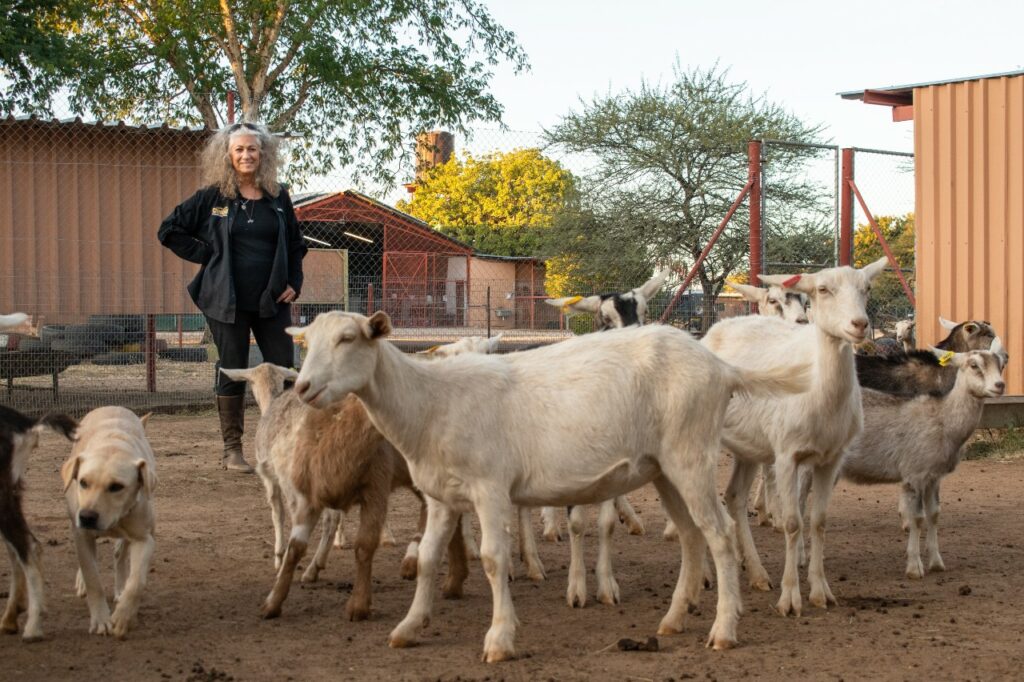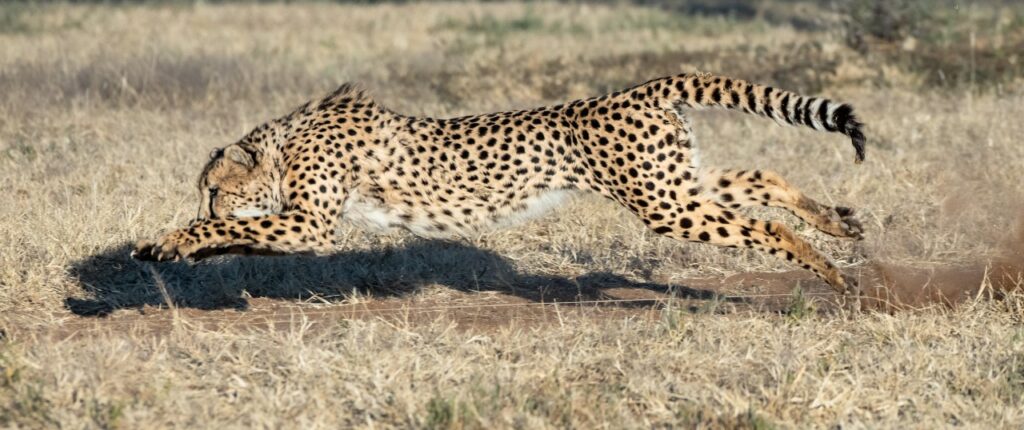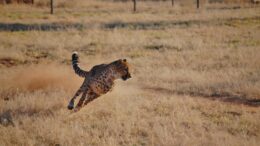Today we know a good bit about cheetahs: They’re the fastest land animal, going from 0 to 60 mph in three seconds. They’re expert hunters, although they often lose their prey to bigger predators. And they also face big threats, occupying just 9% of their historic range. But when Dr. Laurie Marker first began working with the animals in the early 1970s, many people didn’t even know if they were a dog or a cat.
“They’ve got dog-like claws,” she explains. “I think that confused all the farmers.”
Marker has dedicated her career to closing that knowledge gap. She began working with cheetahs in 1974 at the Wildlife Safari, a wildlife park in Oregon, which included trips to South West Africa (now Namibia) to research the rewilding of cheetahs born in captivity. During her time there she realized that farmers were killing hundreds of cheetahs a year to protect their herds, and some of the world’s last remaining cheetah populations could be lost.
So in 1990 she moved to Namibia and launched the Cheetah Conservation Fund, an organization that does research, education and conservation to help secure a future for wild cheetahs and support surrounding communities.

Marker spoke to The Revelator about how dogs can help cheetahs, what risks climate change poses, and why addressing poverty would aid conservation.
Where did cheetahs historically range?
Around 1900 there were about 100,000 cheetahs, and they were found throughout Asia and Africa. They had a very large distribution. But by the 1950s they were gone in most of the areas of Asia — the last of the Asian cheetahs are in Iran, and there’s probably less than 20 there. By the 1950s they were gone in India. Today there’s only about 7,000 cheetahs left, and they’re found in about 23 countries in 31 populations, of which 20 of those populations are under 100 individuals.
We have put cheetahs back into India in the last year, and I just got word two of the cheetahs that we actually sent over had a litter of cubs. So today, I think there’s three or four new cubs in India.
Conflicts with people are a big threat to cheetahs. What solutions have you found?
The majority — more than 80% — of the cheetahs found today are outside of protected areas. Here in Namibia, about 90% are found outside of protected areas. When I moved here, it was to find out more about how they were living on the farmlands with livestock farmers and then what kinds of programs could be developed.
What we’ve done in the last 30 years is develop a variety of programs so that cheetahs and people could live in harmony together. Many of those are about good livestock management, good rangeland management and good wildlife management. I think farmers around the world think predators are all going to eat all their livestock. Where we as farmers can actually play a key role in protecting our livestock. It’s not that much work, but you have to think about it. Predators aren’t just out there wanting to eat your livestock. What they want is an easy meal.

So we use livestock guarding dogs, which we breed and place with farmers, that protect their livestock. Around here people mostly have goats, sheep and cattle. And the other area that I work in is up in Somaliland where there’s mostly goats, sheep and camels. Through an integrated program like good livestock management and having dogs, you can actually reduce your livestock loss 80 to 100% and not have to kill predators. We not only like cheetahs, we like all the other predators because predators play a really important role in the health of the ecosystems.
We have leopards, which are harder to live with, but if you get the right practices down, it is all the same. We also have hyenas, brown and spotted, as well as jackals and caracals. Those are the main predators around.
Cheetahs actually are one of the best hunters on the savannas. When they eat, they eat very rapidly and then move away. So there’s usually things left over that allows for more biodiversity. For instance, I always say to the farming community that if you have cheetahs on your land, the cheetah will make a kill and the jackals will be eating off of what the cheetah killed, and the jackal isn’t going to be in your goat yard. Not only is it feeding the jackal, but it’s feeding the birds of prey and all the other insects and small carnivorous mammals. That’s why you end up with greater biodiversity, and that’s the important part of a top predator within a healthy ecosystem.
Are more protected areas needed?
I think in Africa there might be 12 game reserves large enough for cheetahs. Cheetahs have one of the largest home ranges of any animal on Earth. So between the cheetahs and the African wild dogs, which we also work with here, you have huge ranges. And so that means you have to develop programs within those ranges so that the people and the wildlife can live together.
In Namibia about 20% of the land is protected by the government. And then another 20% are conservancies. Namibia is a leader in conservancy management where the communities actually manage their natural resources and they’re able to benefit from that management as well. We’ve been very active in trying to help develop these kinds of initiatives throughout other areas in Africa as well.
Our human-wildlife conflict laws are different from most countries. In many countries people get compensation if they lose their livestock [to wildlife]. And Namibia won’t do that because we believe that you’re developing farmers that are just losing their livestock to get paid. Namibia has tried to be very proactive by having conservancies, by having things like livestock guarding dogs, and good livestock and wildlife management training programs, so that the farmers actually benefit through having access to their own wildlife through ecotourism.
Is there a lot of overlap in the techniques you use and those used by others in the United States and Europe who are working on reducing conflict between livestock and other predators like wolves?
Yes. The livestock guarding dog program started in Oregon and that was back in the middle ’70s and early ’80s, where I learned about it. Now our programs [in Namibia] have been going on since the early 1990s and we have spread the word. We published all of our data. People monitor what we do very closely. We work with a Turkish breed called the Anatolian Shepherd and Kangal dogs and they’ve been used for about 5,000 years. I went to Turkey and spent a lot of time learning about how the dogs work from the Turkish herders and they usually have three dogs — a female and two males. The female wakes up and she barks, and the males are huge and go after whatever might be around, but also their bark is loud.
You have to have enough dogs to protect against wolves because wolves are also a pack animal. And so for us, cheetahs aren’t a pack animal, leopards aren’t a pack animal. So we can actually work with individual dogs with herds up to 200 to 300 animals and have great success.
But we also encourage the use of herders as well. I think a lot of people in America don’t utilize [herders] a lot. They throw the animals out in the field, in the open range, and then blame anything that might happen. And I’m opposed to that. I am a livestock farmer myself, we have a dairy goat farm, and my agriculture background is linked together with the wildlife background. For me, I like my livestock and I like the wildlife and I like the predators. I feel it’s my responsibility to take care of my livestock through good management.
What kind of a threat does climate change pose?
Cheetahs are found in the most arid and semi-arid landscapes in all of the world with the poorest people on Earth. The animals are being affected through the loss of habitat and what’s going to happen with climate change. We’ve got much hotter days, longer days that are hot, less days that have rain. All of these are affecting and will affect the movements of the animals, the diseases that potentially animals can get and can carry — the prey base will be very much affected, and the grazing lands. That’s going to shift the migration of these animals and put them possibly in even more conflict with the human population.

I think livelihood development is a really critical part of the solution. [Too much grazing has led to] desertification, you end up with either sand deserts taking over, or with invasive bushes taking over, or thickened bushes. We’ve developed a whole habitat restoration project because here in Namibia, an area about the size of California is so thickly thorn-bushed that it has reduced the economic value for agriculture as well as the grazing lands for the wildlife and livestock.
We see this in many of the areas where cheetahs are found because of the effect of this overgrazing by the livestock. With this form of desertification — where you’ve got thickened thorn bushes, no grasses, and then the underground water is being taken up by these invasive bushes — it causes even a greater effect for climate change.
What kind of action would you like to see?
I don’t think anybody in the western world really cares about the poor people that I work with in the middle of Africa, but I really care about them and they don’t want to be poor starving farmers. It’s getting worse and worse. We are helping develop alternative livelihoods and funding to assist greater wildlife and livestock management techniques to help the people get out of poverty.
Then we can have more habitats where animals like the cheetah can live, and when you end up with a top predator, like a cheetah, you end up with a much greater amount of biodiversity.
Often these arid landscapes are called “dead lands,” but they’re only dead because they’re overgrazed and the biodiversity isn’t there. We really need to re-establish biodiversity and it can be done, but we first need to reduce the impact on the land by people. And that revolves around poverty reduction plans, education and the development of conservancies.
I think that the cheetah can be an icon — it can help people accept predators on a worldwide basis, but we just need to understand that we can live together.
Previously in The Revelator:
Is the Jaguarundi Extinct in the United States?
![]()


